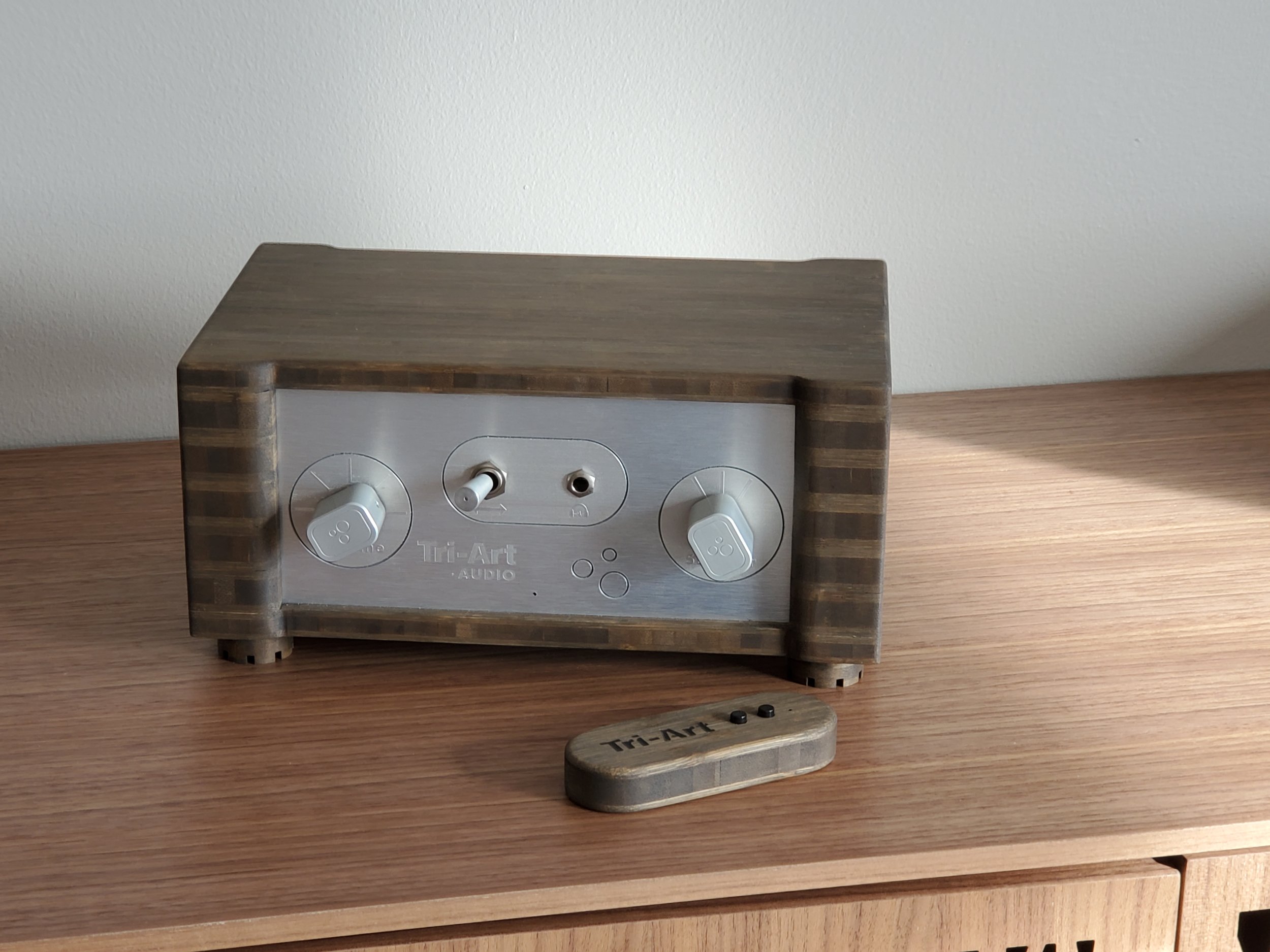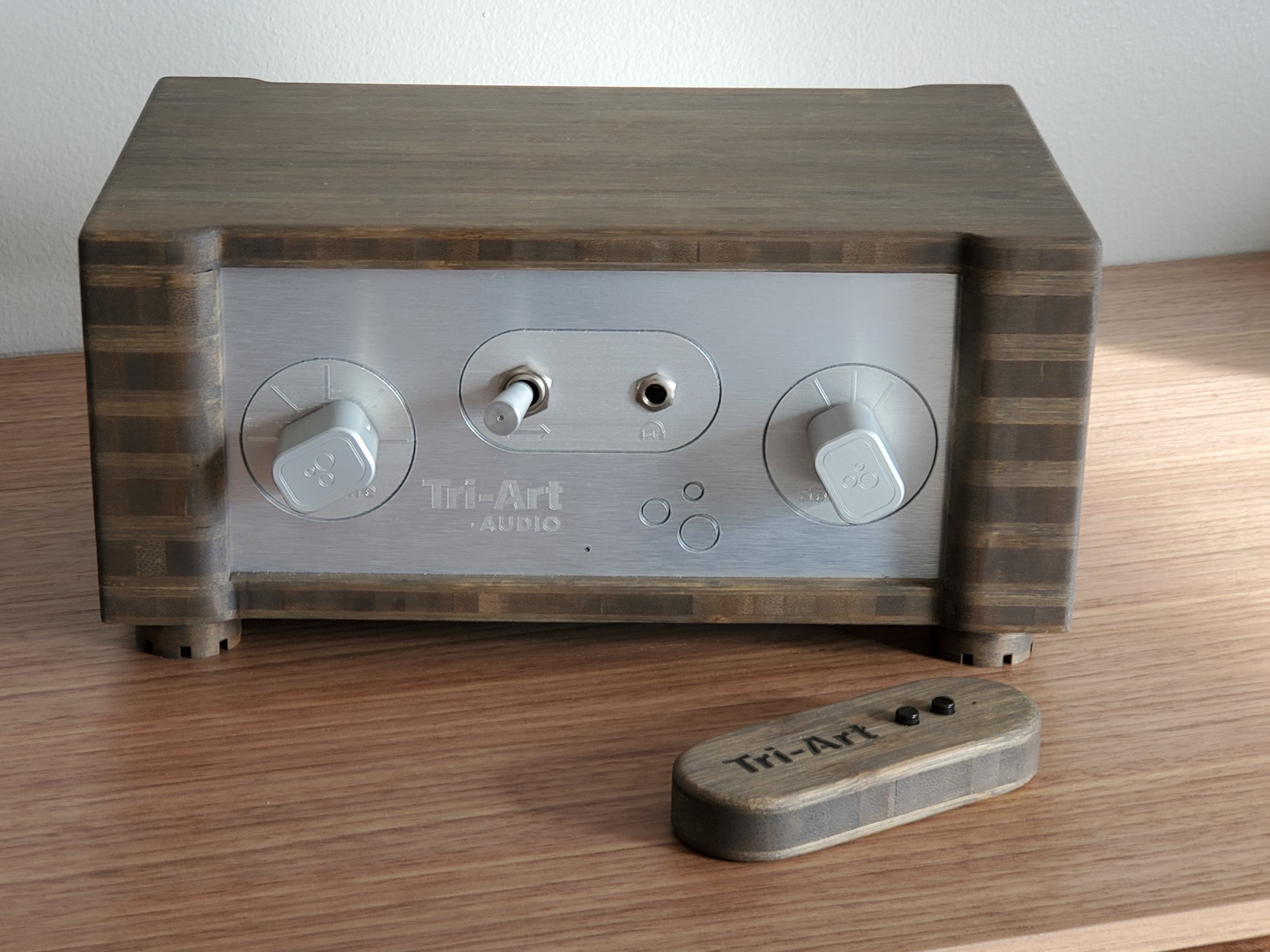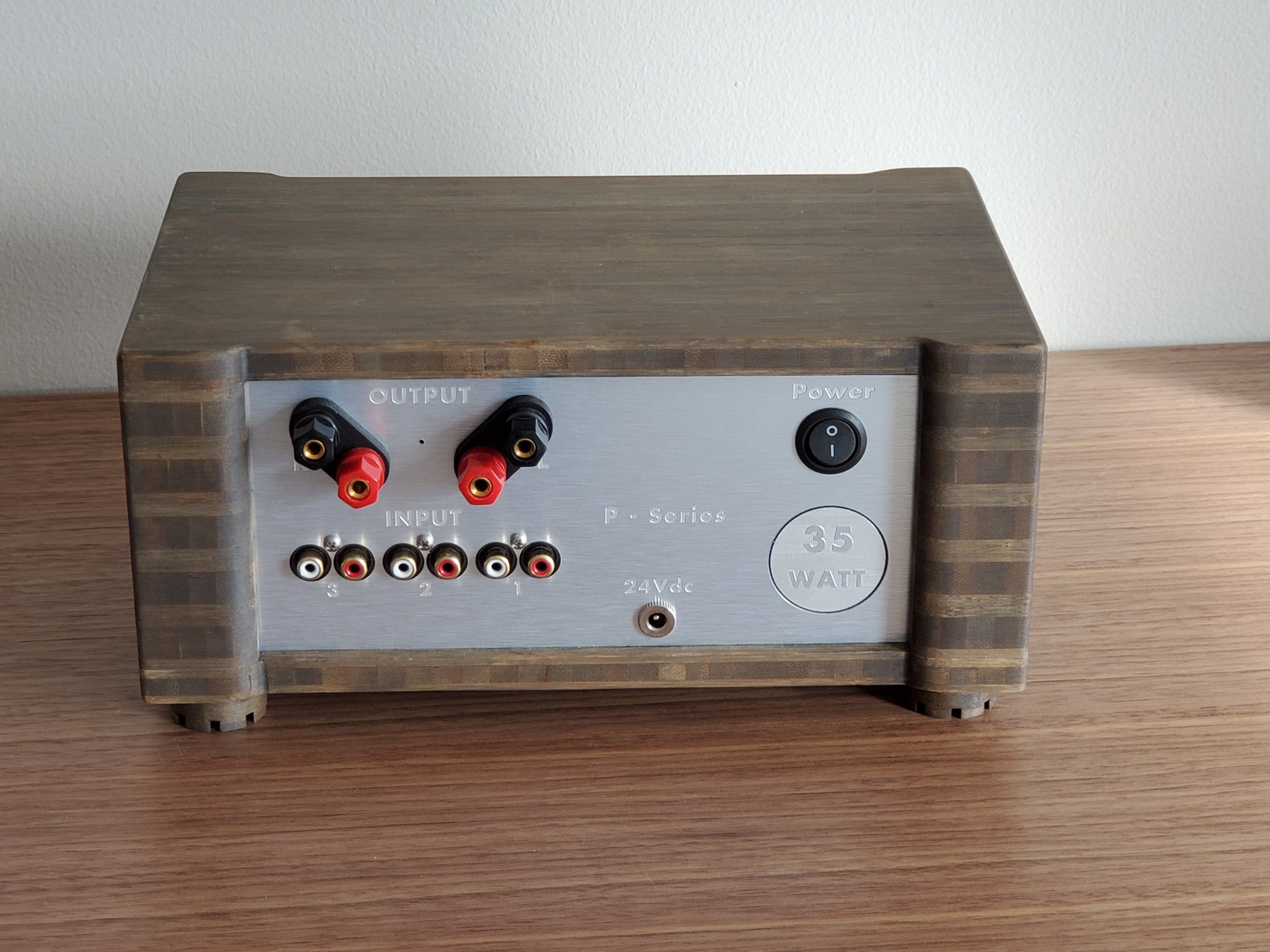THE TRI-ART P-SERIES INTEGRATED - REVIEW
THE TRI-ART P-SERIES INTEGRATED - REVIEW
As noted in the earlier review of the headphone section of the Tri-Art P-Series Integrated (Tri-Art PSI), the Tri-Art company is the brainchild of Steve Ginsberg. Steve is an artist and painter whose overriding philosophy is that everyday working people deserve to hear their music—CDs, albums, streams, and stored music—in the best possible way.
And through the combination of out-of-the-box innovative thinking, attention to detail, utilizing nature’s highest-end materials—bamboo (nature’s carbon fibre), wool, hemp oil—Steve achieves an extremely quiet, transparent, musical, and highly engaging sound via his various components. In point of observable truth, his components will hold your attention for unassailed hours. And these very same Tri-Art Audio components, from source to speakers, populate Steve’s own system.
Tri-Art Audio produces perhaps one of the most demonstrably environmentally friendly components I’ve ever come across, and yet there are a diminishing number of products at even twice its price that can compete. And the pièce de résistance—a most important thing—is that its pricing from top to bottom is a breath of fresh air, and especially so when manufacturers would rather sell “bling.”
This review brings me to the examination and review of the Tri-Art PSI as an integrated amplifier, having already reviewed its headphone amplifier.REFRAIN: Unlike most reviews, this review will be non-sequential, as it will start, below, with how the equipment actually sounds and not the process of physically “undressing” it and/or laying out its various parts, specifications, etc. Think of this review then, as a non-linear movie—Memento, Kill Bill, Arrival, Eternal Sunshine of the Spotless Mind, The Terminator, In the Shadow of the Moon, The Queen’s Gambit, etc—that, likewise, starts at the end and winds its way to the beginning.
The Sound
Well, the integrated apple does not fall very far from the headphone amplifier tree, or something to that effect. Which is to say that the Tri-Art PSI is wonderfully musical, detailed, and transparent, very much like its contained symbiont—the headphone amplifier. Note that this is not always the case, as more often than not less attention is paid to what ostensibly becomes an add-on. This is not at all the case with the Tri-Art PSI.
Firstly, the Tri-Art PSI was, well, handicapped. That is to say, there were no “appropriately priced” speakers in-house, so it had to “play” with the big boys—its nearly five-times more expensive, power-demanding sibling, the OPEN 5 (review coming) and the Verity Otello (review coming) at 13(!) times its price. Normally, this would doom a much lower priced integrated and potentially expose its weaknesses. However, this was not the case, as the speakers instead showed its strengths.
The Tri-Art PSI via the above loudspeakers proved to be every bit as coherent and every measure as transparent, resolving, detailed, and musical as its headphone amplifier, if not more. There were many late nights when listening to the Tri-Art PSI at low volume, time and again, overpowered the necessity to review (as a deadline neared). To offer so much at its $995 to $1,500 asking price (distressed finish) is truly astonishing. I shake my head even now as I consider the Tri-Art PSI's value to price ratio, which is outstanding.
The Tri-Art PSI’s volumetric cube—its soundstage—(with both speakers) is quite wide and quite deep, and with good height. Spatial recreation—horizontal positioning, layering, relative space, air and ambiance—are all very good and far more than you’d expect from an integrated at this price point. Value? Absolutely!
The Tri-Art PSI was partnered with the Silent Angel Munich M1 & Forester F1, the Border Patrol SE-i DAC, the DENAFRIPS Pontus II DAC, the Tr-Art OPEN 5, and the Verity Otello speakers. Cabling was ANTICABLE. Power conditioning was handled by Audience.
As the OPEN 5 is much closer to the Tri-Art PSI, I used the OPEN 5 for the great majority of the review. Another caveat, of course, is the room. A room might well be considered the N+ component in a system, as it can weigh quite heavily, or barely at all, on a system’s voicing. The room in question, measuring 15.25’ x 31’ x 10’, with hardwood floors muted by carpet and padding, a slotted absorption/diffusion oriented console from BDI, angled blinds, and overstuffed furniture, tamed the room well and allowed the sound to remain vibrant and alive.
BASS
Caveat: The Tri-Art PSI bass response becomes a bit more complex as it is, first, susceptible to the loudspeaker’s limitation and secondly, to the room in which the loudspeakers live. These are conditions that its headphone amplifier, affixed to a pair of headphones, does not suffer. That said, and with its related kin—Tri-Art OPEN 5—with a low end that begins its “drop” at or around 35Hz, the sub-bass strata (read near 20-25Hz), is hard to reach, and given the OPEN 5’s true sensitivity (review coming), low bass was virtually impossible. This fact excused the Tri-Art PSI from playing Eiji Oue’s “Infernal Dance of King Kashchey” (Stravinsky, Reference Recordings), as a much more sensitive speaker was needed, true to its specifications. I’ll revisit this shortly.
However, Marcus Miller’s Power (M2, Concord) and Christian McBride’s “Fat Bach and Greens” (Conversation with Christian, Mack Avenue Records), which did not require subterranean searches for the Holy-Bass-Head-Grail, provided good tight, transparent, and well resolved bass, which was transient quick and rollicked and rolled, befitting of a much more expensive integrated.
MIDRANGE
In this particular case, I returned to three vocal pieces that always tell on a piece of equipment for what it can discern and what it cannot. While the pieces are well recorded, there are segments within that can “hide” from less talented components and even from some quite talented components. Olafur Arnalds’ “Árbakkinn” (Island Songs, Mercury (Universal France)) begins with the poetry of Einar Georg Einarsson and birdsongs captured from outside the recording studio, where the birds appear to join in unison. Einarsson’s voice is natural, clear, textured, and there is good presence. The resolution and transparency of the Tri-Art PSI, while good, do not capture the earliest entry of the birds, as do the best, but they are there. Eleonore Sian Cockerham’s “Prayer to a Guardian Angel” (Lux, Decca Music Group Ltd.) is another piece that can hide information in plain sight if the component is not up to task. In the first few lines of verse, there comes a line that is not easily discernible for a number of components that are good to very good. The Tri-Art PSI in this instance takes the lead from its upstream mates and “preserves” this line. The Tri-Art PSI’s midrange is thus very transparent, resolves that which is difficult, is nicely detailed, natural, and beautifully musical. The combination makes for an easy and immersive engagement with the music.
TREBLE+
Of course, Dave Brubeck’s “Take Five” (Time Out, Columbia-Legacy) is enlisted to ferret out the Tri-Art PSI’s treble response. And you don’t have to wait long to note that Joe Morello’s cymbal work is beautifully resolved, very nicely transparent with the required air, ambiance, and shimmer to rise to three-dimensionality from two. There is no Scchshhsss or things frying on too hot a fire with the Tri-Art PSI in play. The Tri-Art PSI is natural, three-dimensional, and has wonderful tone and timbre. The Tri-Art PSI comports itself exceptionally well for a $995 to $1,500 integrated amplifier with a superb HPA.
THE WRAPPINGS AND ACCESSORIES
The Tri-Art PSI now comes in a medium-sized, nondescript brown box, with a picture of the integrated on its front face.
Inside, the Tri-Art PSI is still protected by a great volume of black foam sheets. Accessories include a remote control and a power cable/adapter.
The packaging, overall, is simple, straightforward, clean, and environmentally friendly.
DESIGN—LOOK, FEEL, AND TECHNOLOGY
Little has changed overall with the Tri-Art PSI. It is still wrapped in a bamboo overcoat, but in this iteration it is stained, beautifully, in a “distressed” coloured coat. Its front design layout has changed, for a more stylish and accessible look, and all input/outputs are easily accessible.
The Tri-Art PSI is a well designed, compact, clean, and environmentally friendly component, which, as I mentioned in its earlier review as a headphone amplifier, “… absolutely works and looks rather cute.”
THE SPECIFICATIONS
TRI-ART AUDIO P-SERIES INTEGRATED
Power: 35W per Channel Continuous @ 8Ω
Class: Class D, Single Ended
Power Supply: 24 Volt DC 5 Amps
Pre-Amp: Pre-Amp Section Shunt Resistor Design
Headphone: 6.35mm (1/4") Jack, built in Headphone Amplifier with Power Switch
Input: Three (3) Stereo RCA Inputs
Balanced: No
Output: One Stereo Gold Plated 5-Way Binding Post
Cabinet: Bamboo with 1/8” Anodized Aluminum Face Plate\
Remote: Bamboo Encased Remote Control Included
Dimensions: H: 5.5ʺ (13.97cm) L: 11.25ʺ (28.58cm) W: 6.75ʺ (17.15cm)
FUNCTIONALITY
The Tri-Art P-Series Integrated is a remote-controlled, 35-watt integrated/headphone amplifier. It operates in Class D, single-ended mode and utilizes a 24 Volt DC 5 Amps external power supply.
The Tri-Art PSI contains the same operational controls—volume knob, input selector, Headphone or Amp selector switch—and wears the same 1/8” anodized aluminum plate. The Tri-Art PSI comes with a two-button, oblong, volume-only remote control. The Tri-Art PSI’s back face shows three sets of inputs, speaker terminals, an On/Off switch, and a wall wart power jack.
And as earlier mentioned:
"It’s very straight forward, functionally, and can be up and running in just a few minutes. Jim Leveille of Tri-Art Audio suggests a burn-in period of several days of continuous music playback to get it all ready to go. Jim also suggests a state of ‘continuous on’ for best performance.”
CONCLUSION
The Tri-Art P-Series Integrated is truly a breath of fresh air. It brings a transparency and an openness, a naturalness and musicality that belie its price in favour of a much more expensive component. Add its very good headphone amplifier and it’s possible that you’re looking at a three-to-one pricing advantage over the competition.
We, AudioKeyReviews, highly recommend the Tri-Art Audio P-Series Integrated and award it our HIGH NINES award for all around excellence in a sweet and affordable package. We suggest that it find the shortest of your short lists for adoption into your family and that you pair it with speakers of 89dB+ sensitivity, with a relatively stable impedance curve. If, of course, you are a lover of music, salute.
Pros: Beautifully transparent, natural, and open with a wonderful musicality that will easily draw you in.
Cons: Must be paired with efficient speakers or those with relatively flat impedance curves.
THE SYSTEMS
Silent Angel Munich M1
Silent Angel Forester F1
Silent Angel Bonn N8 Pro Network Switch
Border Patrol SE-i
DENAFRIPS Pontus II
LYRIC Ti 100 Integrated
Tri-Art OPEN 5 Speakers
Verity Otello Speakers
AntiCable Wires/Cables
Audience
THE COMPANY
Tri-Art Audio
Tri-Art P-Series Integrated ($995-$1,500)
4 Harvey Street
Kingston ON K7K 5B9
www.triartaudio.com







